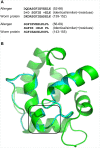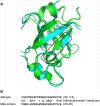Comparisons of Allergenic and Metazoan Parasite Proteins: Allergy the Price of Immunity
- PMID: 26513360
- PMCID: PMC4626114
- DOI: 10.1371/journal.pcbi.1004546
Comparisons of Allergenic and Metazoan Parasite Proteins: Allergy the Price of Immunity
Abstract
Allergic reactions can be considered as maladaptive IgE immune responses towards environmental antigens. Intriguingly, these mechanisms are observed to be very similar to those implicated in the acquisition of an important degree of immunity against metazoan parasites (helminths and arthropods) in mammalian hosts. Based on the hypothesis that IgE-mediated immune responses evolved in mammals to provide extra protection against metazoan parasites rather than to cause allergy, we predict that the environmental allergens will share key properties with the metazoan parasite antigens that are specifically targeted by IgE in infected human populations. We seek to test this prediction by examining if significant similarity exists between molecular features of allergens and helminth proteins that induce an IgE response in the human host. By employing various computational approaches, 2712 unique protein molecules that are known IgE antigens were searched against a dataset of proteins from helminths and parasitic arthropods, resulting in a comprehensive list of 2445 parasite proteins that show significant similarity through sequence and structure with allergenic proteins. Nearly half of these parasite proteins from 31 species fall within the 10 most abundant allergenic protein domain families (EF-hand, Tropomyosin, CAP, Profilin, Lipocalin, Trypsin-like serine protease, Cupin, BetV1, Expansin and Prolamin). We identified epitopic-like regions in 206 parasite proteins and present the first example of a plant protein (BetV1) that is the commonest allergen in pollen in a worm, and confirming it as the target of IgE in schistosomiasis infected humans. The identification of significant similarity, inclusive of the epitopic regions, between allergens and helminth proteins against which IgE is an observed marker of protective immunity explains the 'off-target' effects of the IgE-mediated immune system in allergy. All these findings can impact the discovery and design of molecules used in immunotherapy of allergic conditions.
Conflict of interest statement
The authors have declared that no competing interests exist.
Figures









References
-
- Fallon PG, Mangan NE (2007) Suppression of TH2-type allergic reactions by helminth infection. Nature reviews Immunology 7: 220–230. Available: http://www.ncbi.nlm.nih.gov/pubmed/17318233. Accessed 23 May 2014. - PubMed
-
- Maizels RM, Yazdanbakhsh M (2003) Immune regulation by helminth parasites: cellular and molecular mechanisms. Nature reviews Immunology 3: 733–744. Available: http://www.ncbi.nlm.nih.gov/pubmed/12949497. Accessed 23 May 2014. - PubMed
-
- Pontes-de-Carvalho L, Mengel J (2014) A Question of Nature: Some Antigens are Bound to be Allergens. Frontiers in immunology 5: 373 Available: http://www.pubmedcentral.nih.gov/articlerender.fcgi?artid=4122158&tool=p.... Accessed 22 December 2014. 10.3389/fimmu.2014.00373 - DOI - PMC - PubMed
-
- Hagan P, Blumenthal UJ, Dunn D, Simpson AJ, Wilkins HA (1991) Human IgE, IgG4 and resistance to reinfection with Schistosoma haematobium. Nature 349: 243–245. Available: http://www.ncbi.nlm.nih.gov/pubmed/1898985. Accessed 23 May 2014. - PubMed
-
- Rihet P, Demeure CE, Bourgois A, Prata A, Dessein AJ (1991) Evidence for an association between human resistance to Schistosoma mansoni and high anti-larval IgE levels. European journal of immunology 21: 2679–2686. Available: http://www.ncbi.nlm.nih.gov/pubmed/1936116. Accessed 23 May 2014. - PubMed
Publication types
MeSH terms
Substances
Grants and funding
LinkOut - more resources
Full Text Sources
Other Literature Sources
Medical
Miscellaneous

